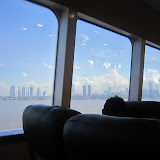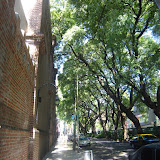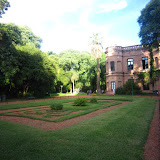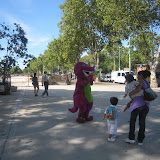Setting aside the raging hormones of its youth population, Buenos Aires definitely requires a bit of getting used to. At 13 million people, it is the second biggest metropolitan area in South America (after Sao Paolo) and seventeenth biggest in the world (ahead of London, Beijing, and all U.S. cities other than New York and Los Angeles). And it has all of the bustle accordant with such a ranking. Arriving here as a tourist is a bit comparable to being dropped in midtown Manhattan and told, "ok, go." There are so many options it can be tough to know where to start. Moreover, the moment you hit the street, there are thousands of people walking with a purpose, and you're just another one of them. It's almost enough (I said "almost") to make me understand why some tourists never leave Times Square. It's certainly a significant change from Montevideo, which the orientation literature from my new school refers to with a single somewhat dismissive sentence: "Montevideo is a small, quiet city and it has a beach."
Argentinos have a bit of a reputation for arrogance, and it does seem to show up when they discuss Uruguay--although one of my teachers said they could learn a great deal from the recent successes of the Uruguayan government in enhancing the quality of life of its citizens. The distaste, as it happens, is mutual. A taxi driver in Montevideo told me "Argentina is a beautiful country. It's a shame it's full of Argentinos." The people I've met here have generally been perfectly nice, although it does seem a bit more closed off and inaccessible, as a culture. It's probably just a city size thing, of course, but, just as an example, in Montevideo, one rides in the front of a taxi, and the drivers are always gregarious and talkative. In Buenos Aires, when I sat down in the front seat of the first taxi I took, the driver looked annoyed, and grunted his way through the trip. Subsequent taxistas have been more neutral, at least, but nothing close to the welcoming feel on the other side of the Rio de la Plata.
Fortunately, Buenos Aires is a fantastic walking city. I've walked almost everywhere I've been, though the subway and bus systems are thoroughly useful as well. But walking gives one a much better sense of the overall geography, as well as the structure and interaction of the neighborhoods. So far, I've really just been to the most touristy areas, as evidenced by the fact that I've heard more English spoken on the street here than I've heard in quite some time. Fortunately, as is the case in most places other than New York, the touristy areas often get to be that way by virtue of being places that are worth visiting, so I've seen some good stuff.
The layout of Buenos Aires reminds me a bit of D.C., in that it's a very orderly grid with the occasional surprising diagonal slashing through, and a number of wide-open plazas plopped in for good measure. To further the comparison, the architecture of congress was based on the U.S. Capitol building, and it sits directly opposite the Casa Rosada (literally, "Pink House," pictured above), which houses the president's offices.
The Casa Rosada sits with its back--and its many famous balconies--facing the Plaza de Mayo, home to the one of the more tragic and compelling stories I've come across. During the late 70's and early 80's, the Argentine government--a military dictatorship that seized power from Isabel Perón, Juan's incompetent widow--ruled with a brutally oppressive iron fist. In what's known as La Guerra Sucia ("the Dirty War"), General Jorge Rafael Videla's regime kidnapped, tortured, and/or killed an unknown number of people, with estimates as high as 30,000. Anyone who was suspected of dissidence was dissappeared. Many of the Disaparecidos, as they're called, were ultimately drugged and thrown from planes over the Atlantic Ocean or the Rio de la Plata to drown. Starting in 1977, a group of women met at the Plaza de Mayo to protest, and demand that the government account for their disappeared children. Three of these women were, themselves, disappeared, and eventually sent on a "Death Flight" over the Atlantic. The mothers, however, kept coming. Although the mothers are no longer protesting the government--they announced about five years ago that they no longer had any enemies in power--they still show up to remember the crimes of their former leaders, and to call attention to the ongoing search for their grandchildren. To this day, every Thursday, the Mothers of the Plaza de Mayo (now the Grandmothers of the Plaza de Mayo) gather and keep a vigil in memory of their lost children. I'm not sure how long it goes, but last Thursday's started at 3:30 and was still going when I walked past again at 7:15, so it clearly lasts a while. Videla, meanwhile, will spend the rest of his life in prison--though this after having been convicted and pardoned, and having his pardon subsequently deemed illegal and overturned. I don't know if hell exists, but Videla is one of those people who makes me hope it does.
These days, Argentina's political woes are a lot more tame. They went through a major financial crisis at the start of the 21st century, when a Peso pegged to the U.S. Dollar gave the appearance of increased wealth where there was none (sound familiar?). They have also been hit by the recent crash, and are trying to pull their way through that now. My buddy Matt, who I met in Montevideo, put it very well. The Argentinos carry around this angst of having had all the potential of being a major player on the world stage, but never having achieved it. Regionally, they're being surpassed by Brazil, and though many Americans come here for tourism now, I've had it pointed out to me more than once that Obama still hasn't been here, and that Hillary usually seems to stop at Brazil and head back. I don't really have a lot of advice for them. My ability to lead a nation onto the world stage has never been tested, but I doubt it would go well. But, especially in comparison to Uruguay, which seems quite comfortable with its role in the world, Argentina does seem to have a bit of a chip on its shoulder.
That said, I'm having a lovely time here. The city has a heartbeat that you can feel while you walk, and it's not without its share of quirks (forgot to get that sign made before getting on the subway? No problem!), both of which are things I enjoy. I will also add that the rumors of even-better-than-Montevideo-steak-and-ice-cream are turning out to be true. And, unlike in Uruguay, you can even find the occasional green vegetable, along with some delicious slow food. So, needless to say, I'm looking forward to exploring the city more in the coming weeks, and then going out and seeing what the rest of the country has to offer.
Saludos,
Seth
*It also reminded me of a Mitch Hedberg joke about the song "We Are the World," but that's another thing altogether.
Fotografía:
 |
| Buenos Aires |
 |
| Recoleta Cemetery |
 |
| Buenos Aires Botanic Garden |
 |
| Buenos Aires Zoo Note: The Buenos Aires Zoo, as with most zoos that are not the Sonoran Desert Museum, is a particularly potent combination of totally depressing and utterly mesmerizing. For more on Zoo science and philosophy, check out this Radiolab episode. |












So relived that Flopsy has lived a happy and fruitful life in Argentina. He always did like steak...
ReplyDelete